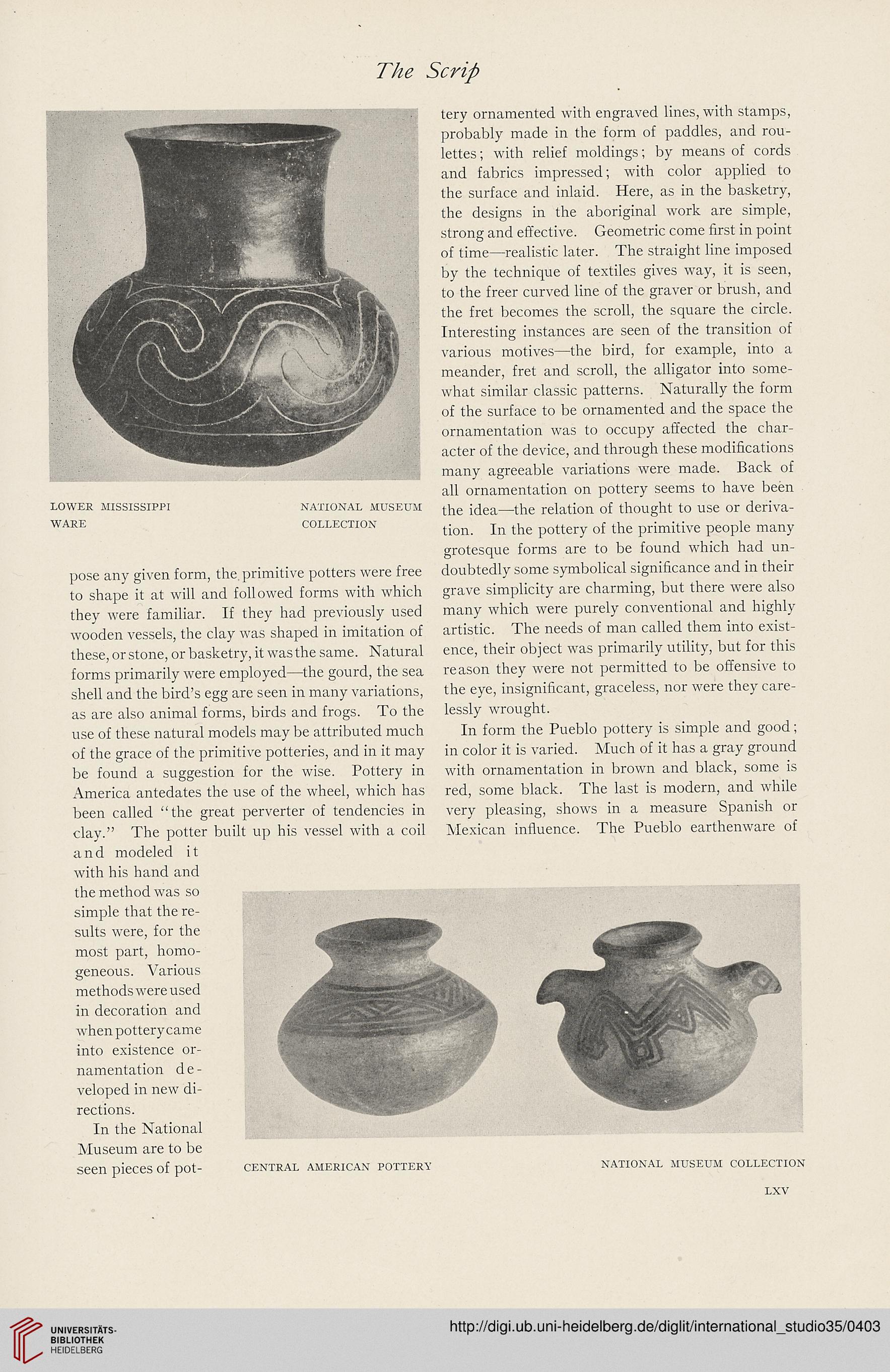The Scrip
LOWER MISSISSIPPI NATIONAL MUSEUM
WARE COLLECTION
pose any given form, the. primitive potters were free
to shape it at will and followed forms with which
they were familiar. If they had previously used
wooden vessels, the clay was shaped in imitation of
these, or stone, or basketry, it was the same. Natural
forms primarily were employed—the gourd, the sea
shell and the bird’s egg are seen in many variations,
as are also animal forms, birds and frogs. To the
use of these natural models may be attributed much
of the grace of the primitive potteries, and in it may
be found a suggestion for the wise. Pottery in
America antedates the use of the wheel, which has
been called “the great perverter of tendencies in
clay.” The potter built up his vessel with a coil
and modeled it
with his hand and
the method was so
simple that the re-
sults were, for the
most part, homo-
geneous. Various
methods were used
in decoration and
■when pottery came
into existence or-
namentation d e -
veloped in new di-
rections.
In the National
Museum are to be
seen pieces of pot-
tery ornamented with engraved lines, with stamps,
probably made in the form of paddles, and rou-
lettes; with relief moldings; by means of cords
and fabrics impressed; with color applied to
the surface and inlaid. Here, as in the basketry,
the designs in the aboriginal work are simple,
strong and effective. Geometric come first in point
of time—realistic later. The straight line imposed
by the technique of textiles gives way, it is seen,
to the freer curved line of the graver or brush, and
the fret becomes the scroll, the square the circle.
Interesting instances are seen of the transition of
various motives—the bird, for example, into a
meander, fret and scroll, the alligator into some-
what similar classic patterns. Naturally the form
of the surface to be ornamented and the space the
ornamentation was to occupy affected the char-
acter of the device, and through these modifications
many agreeable variations were made. Back of
all ornamentation on pottery seems to have been
the idea—the relation of thought to use or deriva-
tion. In the pottery of the primitive people many
grotesque forms are to be found which had un-
doubtedly some symbolical significance and in their
grave simplicity are charming, but there were also
many which were purely conventional and highly
artistic. The needs of man called them into exist-
ence, their object was primarily utility, but for this
reason they were not permitted to be offensive to
the eye, insignificant, graceless, nor were they care-
lessly wrought.
In form the Pueblo pottery is simple and good;
in color it is varied. Much of it has a gray ground
with ornamentation in brown and black, some is
red, some black. The last is modern, and while
very pleasing, shows in a measure Spanish or
Mexican influence. The Pueblo earthenware of
LXV
LOWER MISSISSIPPI NATIONAL MUSEUM
WARE COLLECTION
pose any given form, the. primitive potters were free
to shape it at will and followed forms with which
they were familiar. If they had previously used
wooden vessels, the clay was shaped in imitation of
these, or stone, or basketry, it was the same. Natural
forms primarily were employed—the gourd, the sea
shell and the bird’s egg are seen in many variations,
as are also animal forms, birds and frogs. To the
use of these natural models may be attributed much
of the grace of the primitive potteries, and in it may
be found a suggestion for the wise. Pottery in
America antedates the use of the wheel, which has
been called “the great perverter of tendencies in
clay.” The potter built up his vessel with a coil
and modeled it
with his hand and
the method was so
simple that the re-
sults were, for the
most part, homo-
geneous. Various
methods were used
in decoration and
■when pottery came
into existence or-
namentation d e -
veloped in new di-
rections.
In the National
Museum are to be
seen pieces of pot-
tery ornamented with engraved lines, with stamps,
probably made in the form of paddles, and rou-
lettes; with relief moldings; by means of cords
and fabrics impressed; with color applied to
the surface and inlaid. Here, as in the basketry,
the designs in the aboriginal work are simple,
strong and effective. Geometric come first in point
of time—realistic later. The straight line imposed
by the technique of textiles gives way, it is seen,
to the freer curved line of the graver or brush, and
the fret becomes the scroll, the square the circle.
Interesting instances are seen of the transition of
various motives—the bird, for example, into a
meander, fret and scroll, the alligator into some-
what similar classic patterns. Naturally the form
of the surface to be ornamented and the space the
ornamentation was to occupy affected the char-
acter of the device, and through these modifications
many agreeable variations were made. Back of
all ornamentation on pottery seems to have been
the idea—the relation of thought to use or deriva-
tion. In the pottery of the primitive people many
grotesque forms are to be found which had un-
doubtedly some symbolical significance and in their
grave simplicity are charming, but there were also
many which were purely conventional and highly
artistic. The needs of man called them into exist-
ence, their object was primarily utility, but for this
reason they were not permitted to be offensive to
the eye, insignificant, graceless, nor were they care-
lessly wrought.
In form the Pueblo pottery is simple and good;
in color it is varied. Much of it has a gray ground
with ornamentation in brown and black, some is
red, some black. The last is modern, and while
very pleasing, shows in a measure Spanish or
Mexican influence. The Pueblo earthenware of
LXV




